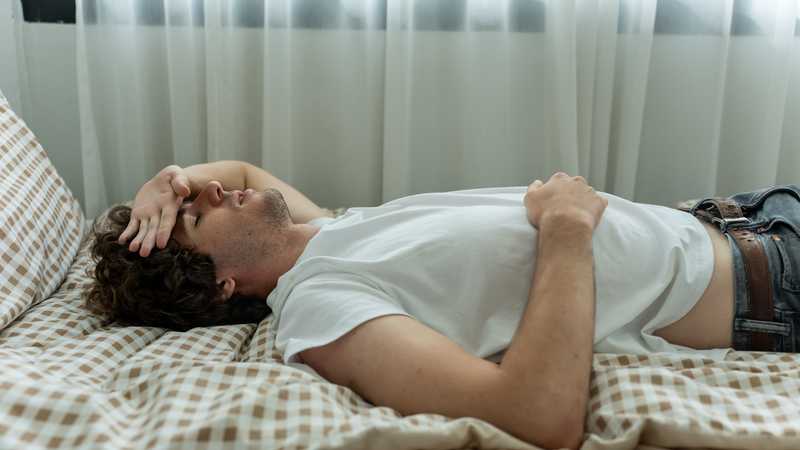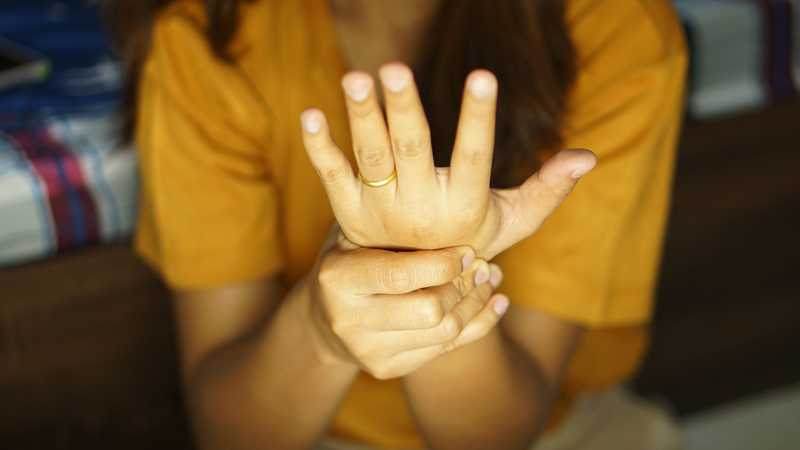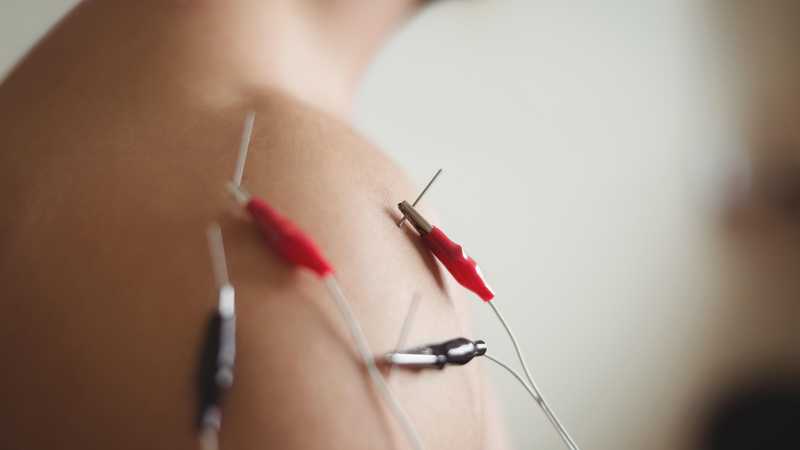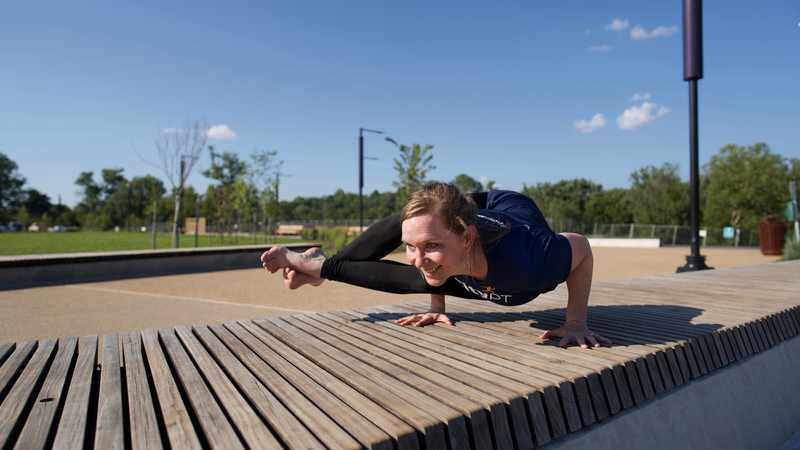If you have issues with shoulder pain when you’re lying down, it can be frustrating and keep you awake at night.
Shoulder pain affects around 18-26% of adults.1 It's a common issue that can get in the way of daily living. But even more frustrating is when it only hurts if you're lying down.
This article will cover why this occurs and go over the common causes of shoulder pain at night. Then, we'll offer you some exercises you can try to potentially give yourself some relief.
Key Takeaways
- The effect of gravity and static postures, while you sleep, can increase pressure on your shoulders and body, which can increase pain.
- Rotator cuff tendinitis and shoulder bursitis are two of the most common causes of pain in the shoulder at night.
- Seated Twist and Child's Pose are two exercises that can help reduce muscle tension in your shoulder and upper torso.
Table of Contents
- Why Only When I'm Laying Down?
- Common Shoulder Pain Issues
- Exercises for the Shoulder
- Homeopathic Remedies for Inflammation
Why Only When I'm Laying Down?
During the day, you are busy, and there is noise and distraction going on around you. However, when you lay down in bed at night, the noise shuts off, and everything goes quiet.
So, if your body is in pain, you'll be more likely to "hear" its messages at night when lying down to go to bed.
There are other reasons for shoulder pain worsening when you lie down; let's investigate them.
Gravity and Your Muscles and Tendons
When you lie down, gravity pushes on your tendons and muscles in different ways, depending on how you lie. The effect of gravity and lack of movement can build up pressure on your shoulder, especially if you sleep on your side.
Sometimes, your positioning can cause disruptions in blood flow, especially when you have underlying inflammation issues, like tendonitis or bursitis, which may lead to pain and discomfort.
Because you don't move much while you sleep, prolonged pressure in certain sleep positions, side lying or stomach sleeping for example, can increase your shoulder pain.
Pressure on Tendinitis
If you have tendonitis, sleeping on your painful shoulder can be especially frustrating. The increased pressure and reduced blood flow from lying still in bed can cause more nighttime pain. You can also experience tingling or numbness in your arm and shoulder.
Increased Inflammation
As you move and use your arms, in some individuals, inflammation can build up but usually goes unnoticed and is manageable throughout the day. But, by the time you go to lie down, sometimes the inflammation in your shoulder can be at a tipping point and feel worse despite resting.
If you have existing medical conditions, you might already have higher levels of inflammation in your body. The inflammation from these medical conditions may also feel worse while you lie in the same position for long periods of time.
Sleeping on your "good" side may help to reduce the pain, or you could try sleeping on your back with your arms down or supported on pillows to reduce your discomfort.
Common Shoulder Pain Issues
Rotator cuff tendinitis and shoulder bursitis are two common conditions that can be the source of shoulder pain at night. Let's examine each one in more depth.
Rotator Cuff Tendinitis
When the tendons in your shoulder's rotator cuff become irritated you can develop rotator cuff tendonitis. Rotator cuff tendonitis is a very common cause of shoulder pain. Your rotator cuff is a collection of tendons and muscles that help you raise your arm and stabilize your arm in the shoulder socket.
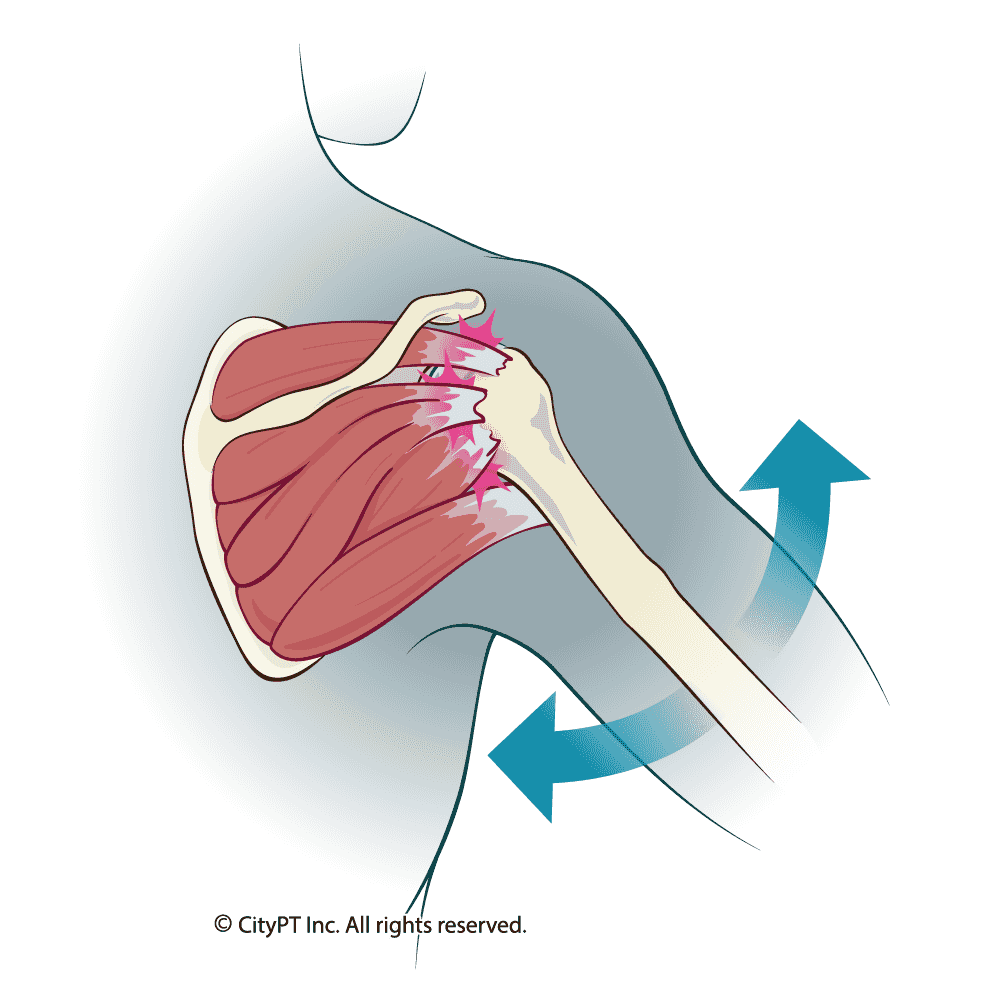
Rotator cuff tendinitis is often considered a type of "overuse" injury. Overuse can cause inflammation. Excessive, repeated overhead movements such as when painting, planting flowers, or playing sports are common triggers of rotator cuff issues.
Some common risk factors for rotator cuff tendonitis are:2
- Age, older than 50 years
- Diabetes
- Overhead activities
Symptoms of rotator cuff tendonitis include the following:
- Pain in the front or side of the shoulder
- Pain when you raise or lower your arm
- Swelling
- Stiffness feeling
- A clicking or popping sound with use
When you have this condition in your shoulder, inflamed tendons, the pain often becomes worse at night, so it can be challenging to get to sleep and stay asleep.
Treatment can include physical therapy, ice packs, and rest. For more challenging tendinitis, steroid shots or surgery may be necessary.
Bursitis in the Shoulder
Bursitis is the inflammation of your bursa. Bursitis of the shoulder occurs when the bursa at the shoulder joint becomes inflamed. The most common bursa in the shoulder joint that gets irritated is the subacromial bursa.
Bursae are tiny fluid-filled sacs that keep your muscles, bones, and tendons from rubbing up against each other. When there is too much friction, these sacs become inflamed and fill up with too much fluid, which causes them to become swollen and painful.
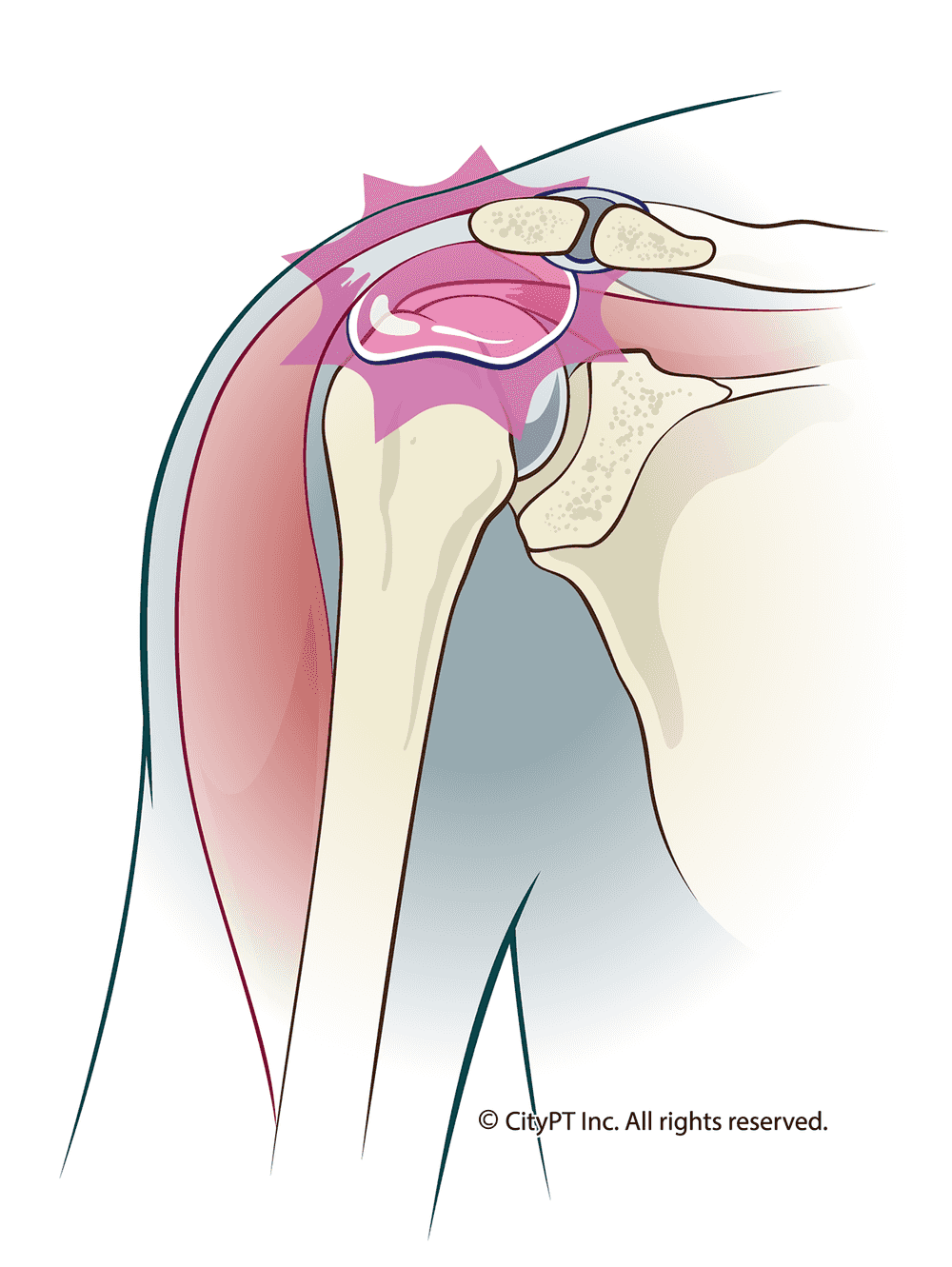
Common risk factors and causes of shoulder bursitis include:
- Repetitive movements, especially overhead
- Underlying medical conditions
- Poor posture
- Arthritis
- Muscle imbalance
- Direct injury or trauma
Impingement syndrome is associated with shoulder bursitis as well.3
Treatment can include rest physical therapy, NSAIDs, and steroid injections.
In particular, if you have shoulder bursitis, laying on your painful side at night can irritate the bursa and put extra pressure on it, worsening the pain when you sleep.
Exercises for the Shoulder
Exercise is a great way to reduce pain and stiffness. Let's look at a few of the exercises for your shoulder that can be used to relieve the pain and inflammation.
WARNING: There are dangers in beginning a DIY exercise program for your shoulder. If you are experiencing pain in your shoulder, we strongly advise you seek diagnosis and treatment by a licensed City physical therapist before performing any of the following exercises.
Seated Twist
The seated twist is an exercise that works on the core and spine but also helps to mobilize the shoulders and upper back. Incorporating seated twists into your daily exercise routine can encourage better posture.
Instructions
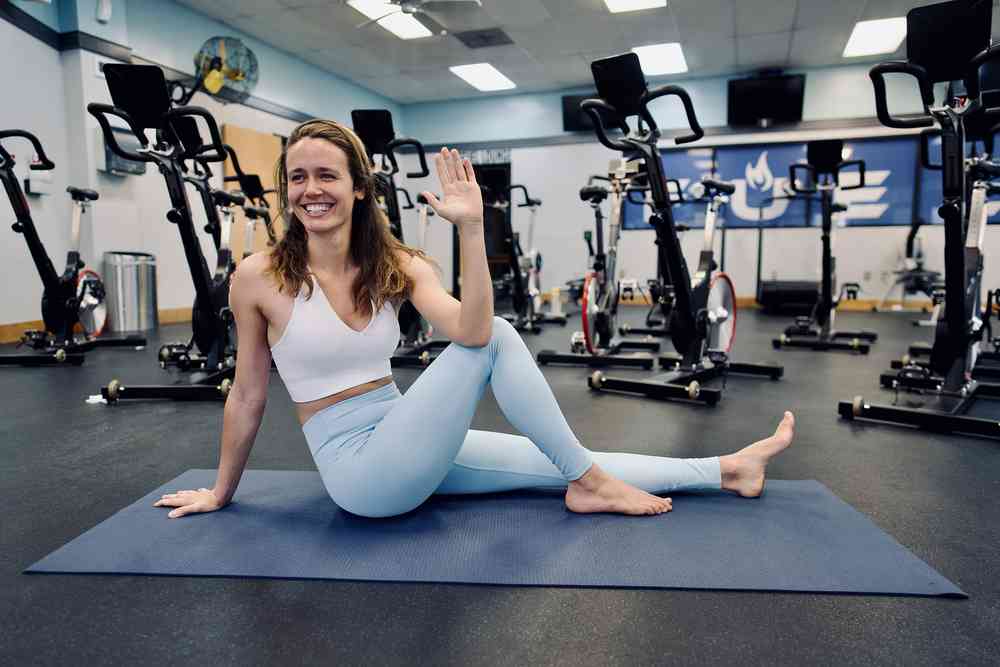
- Stretch your legs straight out in front of you and your arms behind your back while sitting on a mat or blanket on the floor.
- Bend your right leg back behind you, keeping your foot on the floor and near your glutes.
- Keep your hips square.
- Put your left arm behind you, turn your body to the left, and raise your right arm to a high position.
- Take a deep breath and extend the stretch by wrapping it around your bent knee.
- Hold for one minute,
- Let go and repeat the exercise for the other side.
Tip from the clinic: Engage your pelvic floor! Try contracting your pelvic floor muscles, like when you're holding your pee, as you twist your upper body. This will exercise your core muscles and provide a solid base while rotating.
Downward Dog
Tip from the clinic: Although downward dog is a common yoga exercise, if you have active shoulder pain, a flare up or recent injury, I do not recommend it. Downward dog does require bearing weight on your arms and shoulders in an overhead position, which can increase your symptoms.
For people with more shoulder stiffness than pain, downward dog is an excellent yoga pose for improving mobility throughout the body. This exercise also helps to boost circulation and blood flow and increases flexibility specifically in the upper back and shoulders.
Instructions
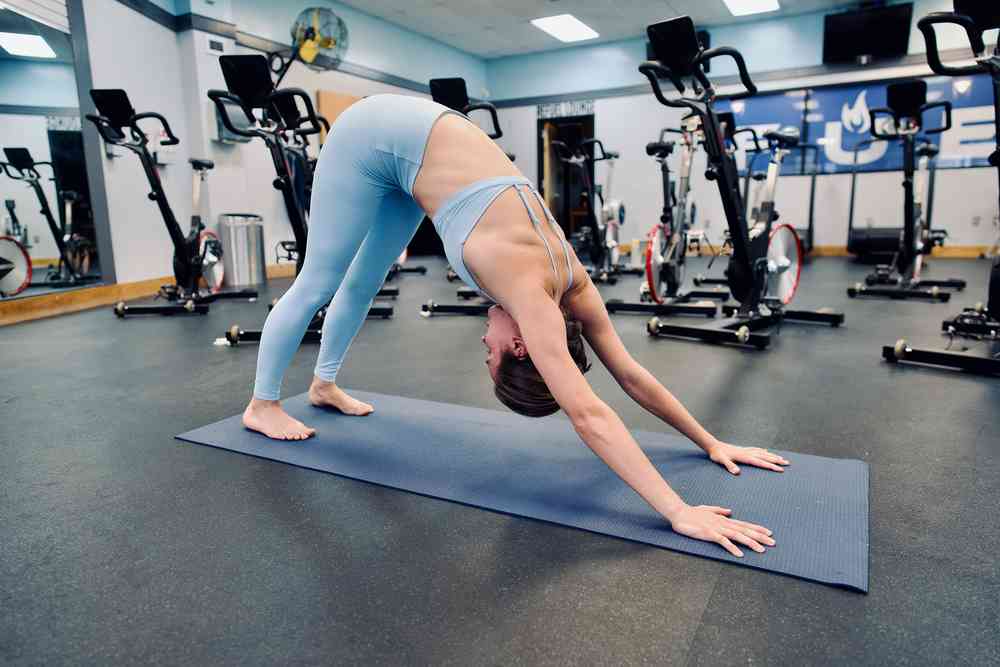
- With a yoga mat or a blanket on the ground underneath you, begin on all fours.
- You want to align your wrists with your shoulders and your knees about hips width in a tabletop position.
- Push your hips up and lengthen your spine, straighten your legs with your feet facing forward, and try not to splay them out.
- Now, walk your hands out in front of you, facing forward, lined up with your feet in the back.
- You will be in an upside-down V-shape with your face facing the mat.
- You want to spread your fingers out to evenly distribute your weight with your fingers and take the pressure off the wrists.
- If your heels don't touch the floor, that's okay; you'll find what is comfortable for you.
- Once in position, hold for 20-25 seconds.
- To release the hold, drop back down to your knees.
Tip from the clinic: If straightening your knees is uncomfortable, feel free to bend them slightly. Do not force the movement! If at any point you feel any discomfort, switch over to a child's pose stretch.
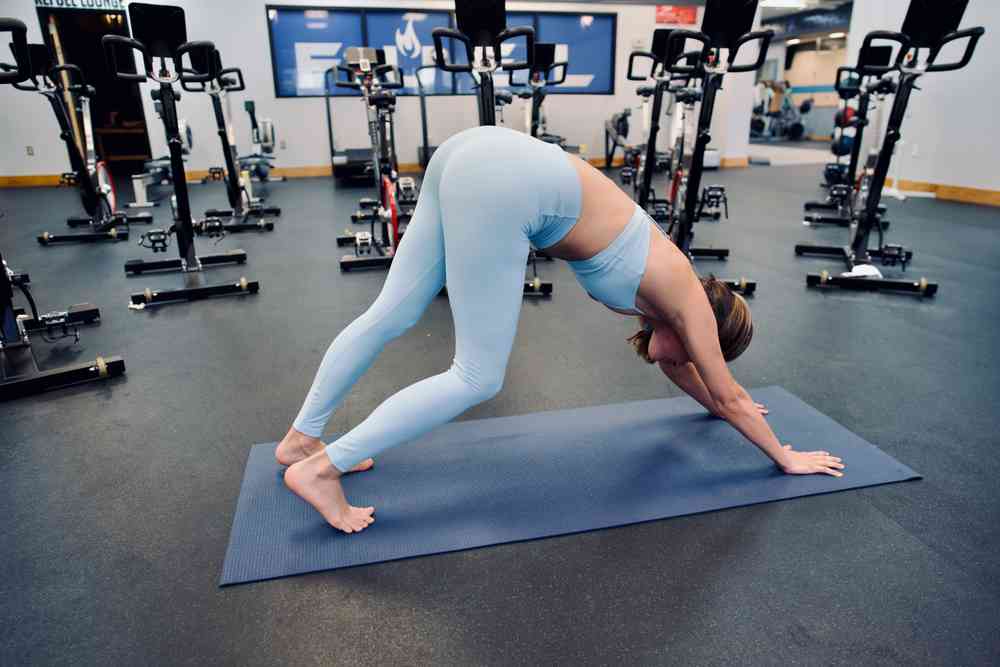
Thread the Needle
Tip from the clinic: Thread the needle is not for beginners or people with active shoulder pain. The positioning requires quite a bit of flexibility throughout the body and strength in the arms and shoulders.
Thread the needle is a deep stretch that targets your neck, shoulder, and upper back muscles. This exercise helps stretch the shoulders, so if you are feeling tight or tense, it may be a good one to try. It's also a good stretch for reducing pain and tension in the body.
Instructions
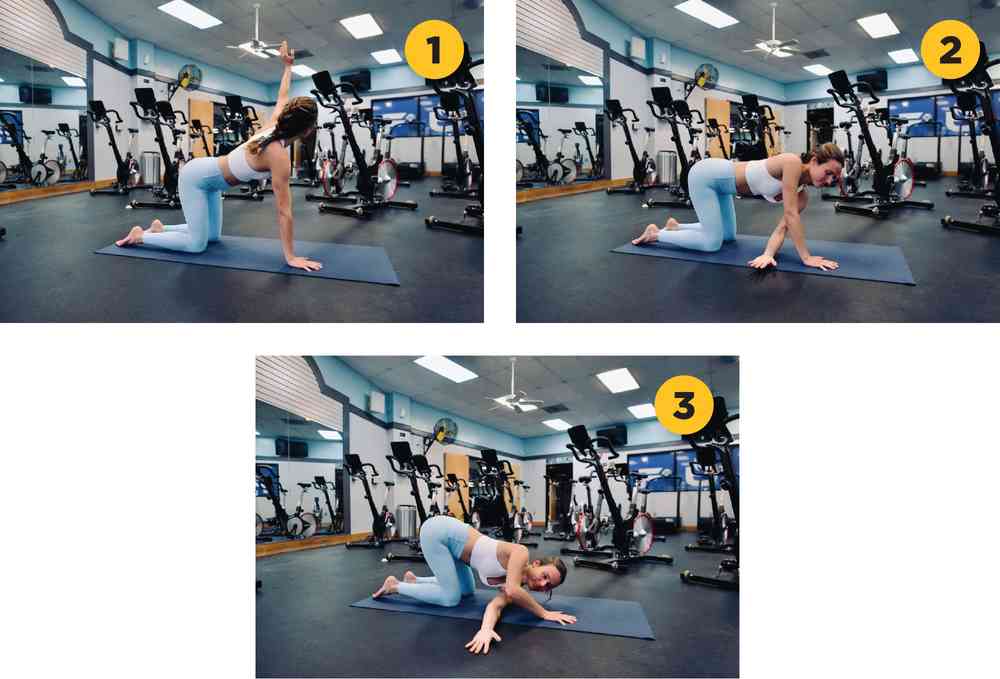
- Get on the floor on a yoga mat or a blanket.
- Begin on all fours with your knees under your hips and your hands at shoulder's width.
- Raise one arm high and look at your fingertips.
- Then thread that arm under your other arm and lay your shoulder and palm face down on the floor.
- Turn your head and face the way your threaded arm is laying.
- Bend the elbow of the supporting arm.
- Use a pillow under your head and neck for support.
- Hold this pose for a minute.
- Now switch sides and do the same with the opposite arms.
- Return to your neutral position. Repeat as many times as you like.
Tip from the clinic: If this exercise is too challenging, you can try the seated twist exercise instead.
Child's Pose
Child's pose is a relaxing stretch you can do easily. It can help to increase blood circulation and relieve tension in the shoulders, chest, and back.
Instructions
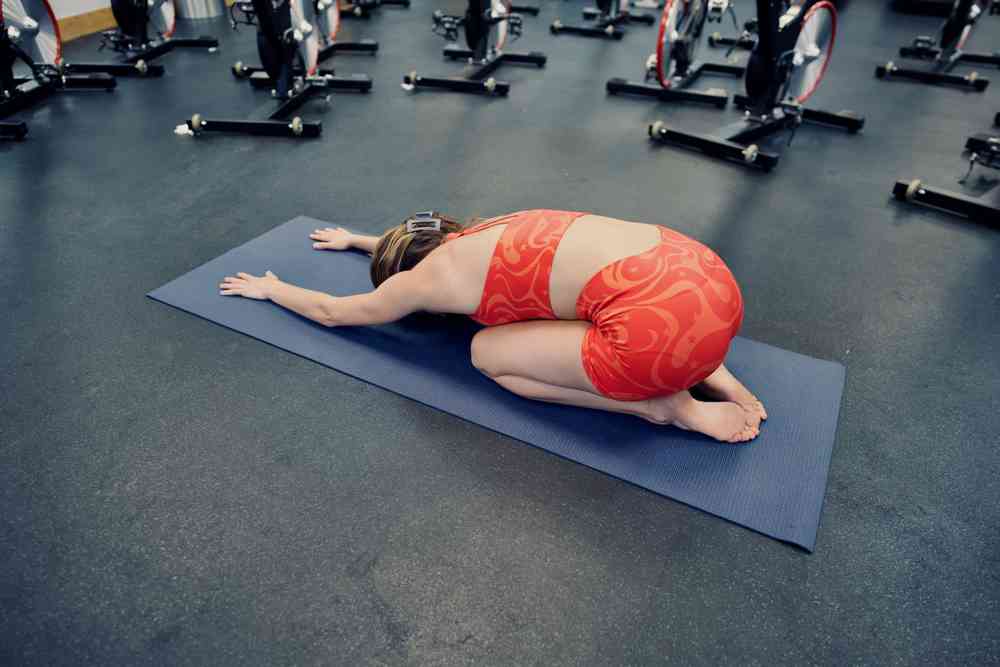
- Get on your hands and knees on a mat or a blanket.
- You'll want to spread your knees about shoulder-width or a little wider.
- Stretch your arms out in front of you until your forehead touches the mat or you feel your limit.
- Place your palms face down on the floor.
- Your stomach may rest on the mat, and you will want to soften your face.
- If you want to vary it up a bit, you can turn your palms up for a deeper shoulder stretch.
- Hold this pose as long as you want. It's meant to be a deep, slow stretch, but you can also benefit from a short, quick child's pose.
Tip from the clinic: If you do not have enough knee range of motion to perform this stretch, try using a towel roll or pillow behind your knees so they do not reach a point of discomfort. You can also use a rolled towel under your forehead and a thick pillow under your belly for more support.
Eagle Arms
Eagle arms is an advanced flexibility exercise and will be challenging for many people. Although it's commonly found in exercises for shoulder pain, I recommend skipping it or modifying it as recommended below.
Eagle arms exercise is the top half of the Eagle pose in yoga. If you have the flexibility, it can be a good posture for activating and strengthening your upper back and shoulder muscles. This posture will also help increase the flexibility of the shoulder joint.
Instructions
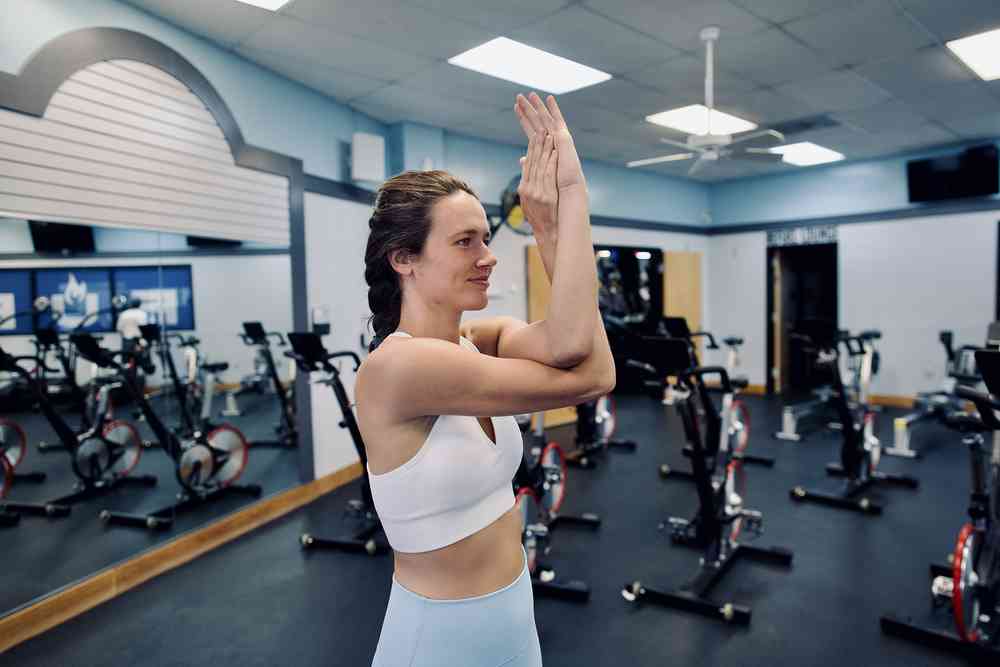
- Stand up straight on a mat or sit down, whichever feels comfortable.
- Reach both of your arms out in front of you.
- Take one arm and wrap it under the other arm, then make a cross at your elbows.
- Then, bend both your arms back together to touch your hands if you can hold them. If not, try to touch or hold your forearm or wrist.
- Now that your arms are twisted up, raise your elbows in the air to shoulder height.
- Hold this position for 10-15 seconds.
- Then unwind your arms and do the same with the opposite arm under this time.
- Hold for 10-15 seconds.
- Unwind.
Tip from the clinic: If twisting your arms and hands is not comfortable, skip that step! Bring your arms together, bend at the elbows and lift as able within a pain free range.
Shoulder Circles
Shoulder circles can relieve muscle tension in your shoulders. This exercise also improves shoulder flexibility and mobility. Regular practice can increase blood flow to the shoulder joint, which should help reduce inflammation at night.
Instructions
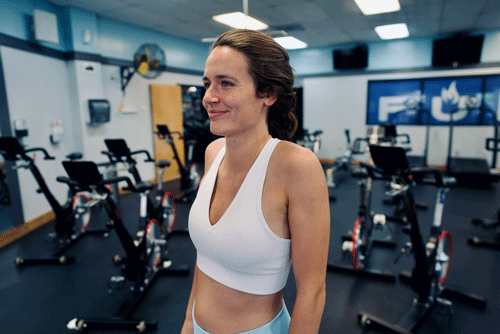
- Stand up tall with your arms down by your side and your feet about shoulder-width apart.
- Roll your shoulders forward in small circles, keeping your arms by your side.
- Rotate forward about five times, then switch the direction of your shoulder circles.
- Rotate backward about five times.
- You can repeat alternating forward and backward circles for a minute or two.
Homeopathic Remedies for Inflammation
Homeopathic medicines are natural remedies to stimulate the body's healing mechanisms. These types of remedies may work on some of the underlying causes of the problem.
There are some excellent homeopathic remedies for inflammation that you can try. A review study shows that certain foods' polyphenols and other plant-based nutraceuticals have anti-inflammatory properties that work well for tendinitis.4

Some of them include:
- Avocado oil
- Bromelain (pineapple)
- Turmeric
- Great tea extract
- Ginkgo Biloba
- Chamomile
- Genistein (found in soybean, broccoli, and alfalfa)
- Horny goat weed
- Quercetin
- Resveratrol (grapes, mulberries, and peanuts)
- Boswellia acid (Boswellia serrata tree)
- Echinacea
Ashwagandha can also help to improve pain and swelling in joints.
Don't Suffer Through Your Shoulder Pain! Get the Help You Need
If you're struggling to find pain relief for your shoulder, consider booking a screening with a CityPT clinician. Thanks to our unique model, CityPT clinicians have more time for their patients and are capable of creating highly personalized therapy programs that can be easily and quickly adapted and improved when needed.
They can also help you maintain and improve your quality of life by helping you live without suffering excessive pain.
This guide is intended for informational purposes only. We are not providing legal or medical advice and this guide does not create a provider-patient relationship. Do not rely upon this guide (or any guide) for medical information. Always seek the help of a qualified medical professional who has assessed you and understands your condition.
References
Footnotes
-
Linaker CH, Walker-Bone K. Shoulder disorders and occupation. Best Pract Res Clin Rheumatol. 2015;29(3):405-423. doi:10.1016/j.berh.2015.04.001 ↩
-
Leong HT, Fu SC, He X, Oh JH, Yamamoto N, Hang S. Risk factors for rotator cuff tendinopathy: A systematic review and meta-analysis. J Rehabil Med. 2019;51(9):627-637. doi:10.2340/16501977-2598 ↩
-
Faruqi T, Rizvi TJ. Subacromial Bursitis. [Updated 2023 Jun 26]. In: StatPearls [Internet]. Treasure Island (FL): StatPearls Publishing; 2024 Jan ↩
-
Mueller AL, Brockmueller A, Kunnumakkara AB, Shakibaei M. Modulation of Inflammation by Plant-Derived Nutraceuticals in Tendinitis. Nutrients. 2022;14(10):2030. Published 2022 May 12. doi:10.3390/nu14102030 ↩

Dr. Srisethnil is an orthopedic specialist with over 15 years of experience in outpatient physical therapy practice. She has worked with sports medicine patients of all ages, managing post-op rehab protocols and return-to-sports programs. She has taught many patient education classes including back care, neck care, knee pain, and office ergonomics.

Dr. Srisethnil is an orthopedic specialist with over 15 years of experience in outpatient physical therapy practice. She has worked with sports medicine patients of all ages, managing post-op rehab protocols and return-to-sports programs. She has taught many patient education classes including back care, neck care, knee pain, and office ergonomics.
